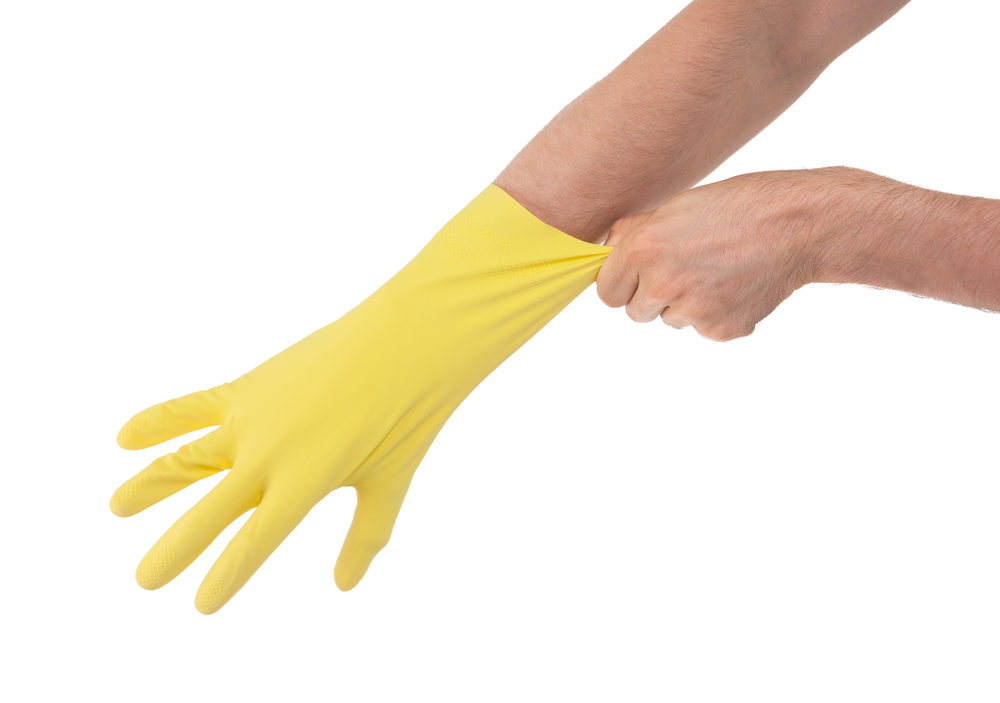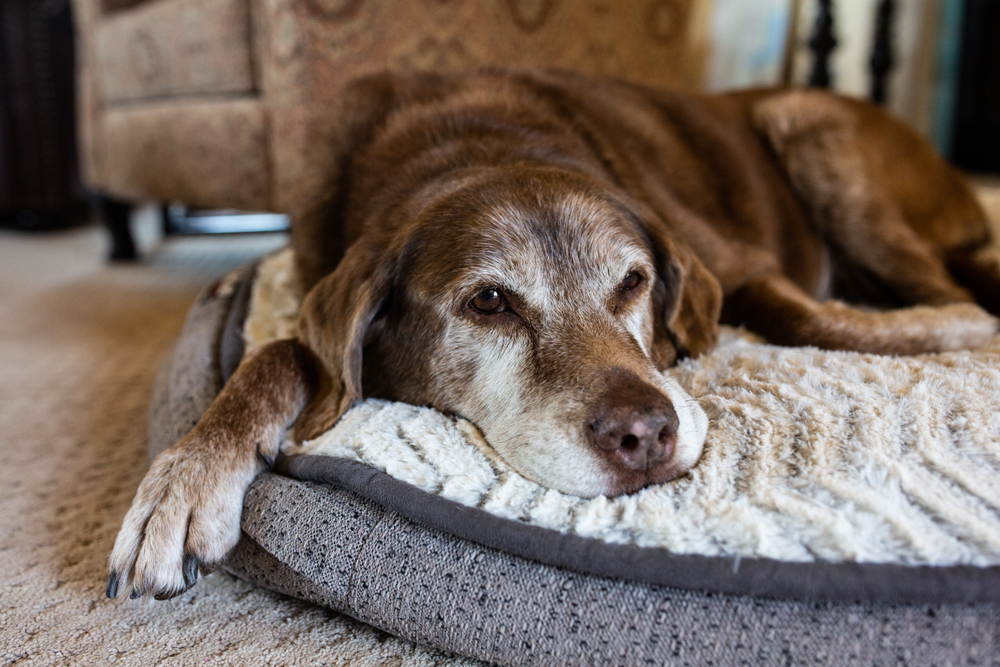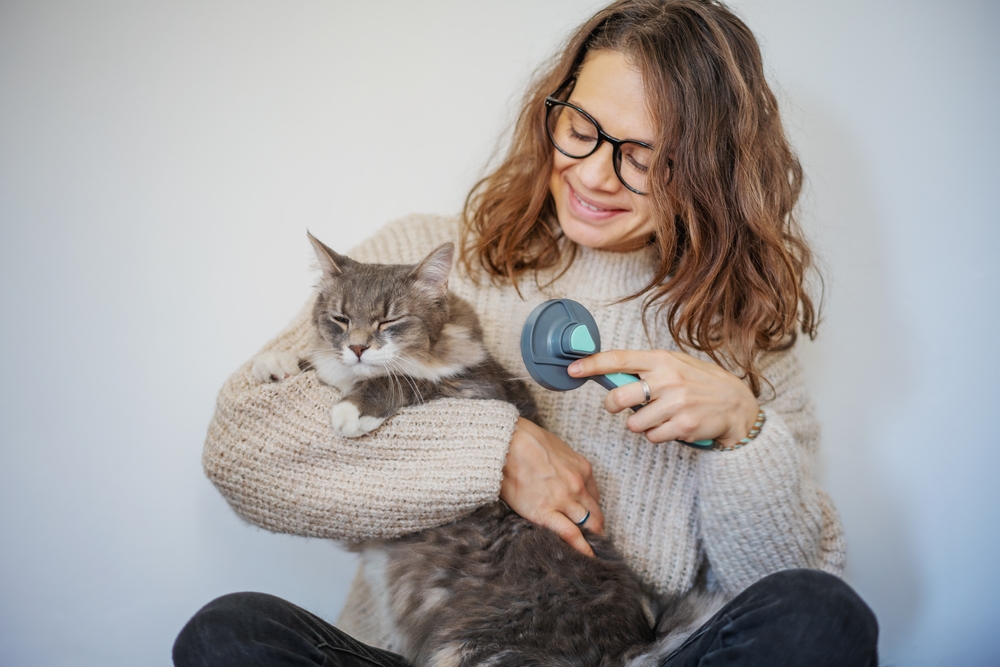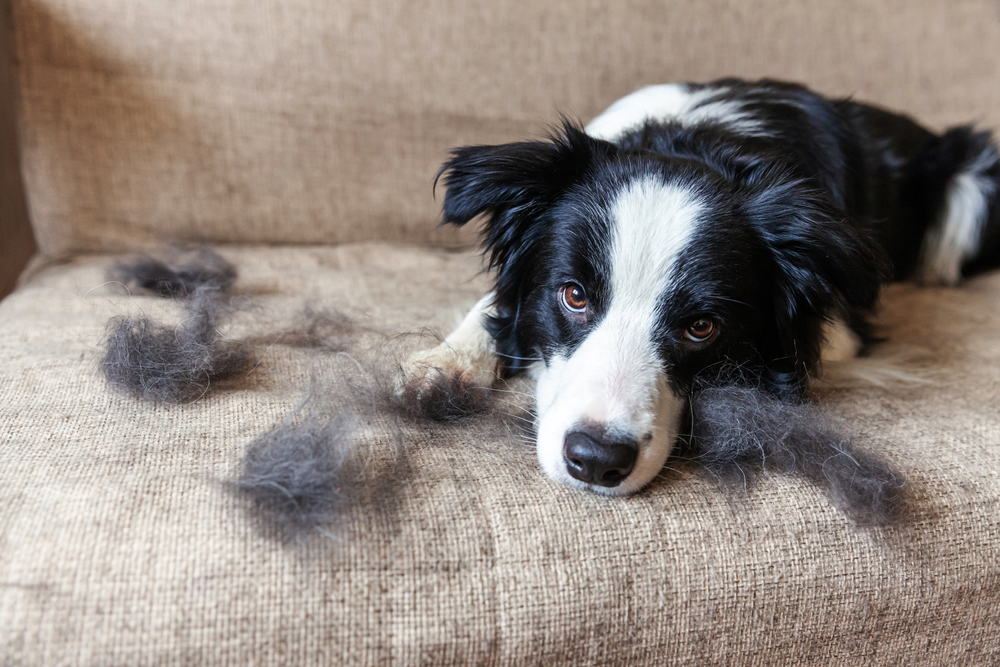Pet hair can be one of the most persistent nuisances in a pet owner’s life, clinging to everything from your clothes to your furniture. It’s a daily struggle between maintaining a clean environment and enjoying the company of your furry friends. With a few clever tricks, though, you can easily manage the fur dilemma and reclaim your possessions. Here are 12 effective ways to keep pet hair at bay and ensure your home stays a comfortable, hair-free zone.
1. Use a Rubber Glove

A simple yet surprisingly effective tool in your anti-pet-hair arsenal is a regular rubber glove. When slightly dampened and run over surfaces, the friction creates static that pulls pet hair off upholstery or clothing. It’s something you probably already have under your kitchen sink, making it a convenient go-to solution. Plus, it’s reusable and environmentally friendly compared to single-use lint rollers.
According to cleaning experts from the American Cleaning Institute, rubber gloves offer a practical and affordable method for hair removal. The texture and material interact with the fibers in fabrics, loosening the embedded fur. You’ll find this technique works particularly well on fabric that tends to grip hair tightly. Best of all, you can rinse and reuse the glove countless times, making it both cost-effective and sustainable.
2. Invest In a Humidifier

Pet hair is more likely to cling to surfaces in dry environments. By using a humidifier, you can add moisture to the air, which helps reduce the static electricity that causes hair to stick. This is especially useful during winter months when indoor air is typically drier due to heating systems. It’s a subtle way to make your home less inviting to hair accumulation.
Beyond helping with pet hair, a humidifier can improve overall air quality and comfort in your home. It’s beneficial for your skin, respiratory system, and even your wooden furniture. Making your living space more comfortable for you and your pets is a win-win situation. Just be sure to maintain your humidifier properly to avoid mold and bacteria build-up.
3. Buy Anti-Static Spray

Anti-static spray can be a game-changer when it comes to pet hair removal. A light spritz on your clothes or furniture can minimize static cling, making it easier to brush off hair. This product is usually found in the laundry section of the supermarket and can make your daily routine significantly easier. It’s especially effective on synthetic fabrics that naturally generate more static.
Dr. Karen Blaker, a domestic cleaning expert, suggests using anti-static spray as an immediate solution for those unexpected moments when your outfit is covered in fur. It’s quick, portable, and can be used on the go to keep your appearance polished. The spray acts as a barrier, preventing hair from embedding into the fibers. This is particularly useful for professional settings where first impressions matter.
4. Opt for an Elite Vacuum Cleaner

The right vacuum cleaner can make all the difference in your war against pet hair. Look for models specifically designed for pet owners, equipped with special attachments and high suction power. These vacuums are tailored to pick up even the most stubborn hair embedded in carpets and upholstery. They often come with HEPA filters, which are essential for capturing allergens and improving air quality.
While these models can be pricier, the investment pays off in the long run by saving time and effort. A powerful vacuum can reduce the frequency of manual cleaning, giving you more time to spend with your pets. Plus, many of these vacuums have bagless designs, making maintenance easier. Regular vacuuming also extends the life of your furniture and floors, preserving the appearance of your home.
5. Use Furniture Covers

Furniture covers are a practical solution for keeping pet hair off your upholstery. They serve as a protective barrier, easily removable and machine washable. With a wide range of designs, you can find covers that complement your home decor while keeping it clean. This method is especially suitable for households with multiple pets or high-shedding breeds.
According to interior design expert Emily Henderson, furniture covers not only protect against hair but also against scratches and stains. They provide an added layer of defense, preserving the look and longevity of your furniture. For an added touch, choose covers made from pet-friendly materials that repel hair and are easy to clean. This means you can maintain a stylish living area without sacrificing practicality.
6. Try a Sticky Lint Roller

Sticky lint rollers are a classic and effective tool for removing pet hair from clothes and fabric surfaces. They are easy to use, portable, and can quickly tackle small areas without much effort. Ideal for those last-minute touch-ups before heading out, a lint roller is a staple in any pet owner’s cleaning kit. You can even keep one in your car or office for unexpected furry incidents.
Despite their convenience, lint rollers can become an expensive habit if used excessively. However, for occasional use, they’re a quick fix that helps maintain a neat appearance. For an eco-friendly alternative, consider reusable lint rollers that use adhesive gel instead of disposable sheets. They offer the same efficiency but with less waste, aligning with a more sustainable lifestyle.
7. Get a Squeegee

A squeegee isn’t just for your windows; it’s surprisingly effective on carpeted areas too. The rubber blade easily collects hair when dragged across the surface, making it an excellent tool for those tricky spots. It’s a manual method, but it can complement vacuuming by reaching hair embedded deep within carpet fibers. Plus, it’s a low-cost solution that can be part of your regular cleaning routine.
A study from the University of Surrey emphasizes the benefit of squeegees in low-pile carpets where hair tends to settle invisibly. The study confirms that a simple squeegee can remove a significant amount of fur, reducing the need for frequent vacuuming. It’s an exercise in patience, but the results are worth it for those areas that seem to defy traditional cleaning methods. Just be sure to clean the squeegee blade regularly to maintain its effectiveness.
8. Wash Pet Bedding Regularly

Pet hair accumulates rapidly on your pet’s bedding, becoming a constant source of loose fur. Regular washing not only reduces hair but also eliminates odors and potential allergens. Use a high-efficiency washing machine and a pet-safe detergent to ensure thorough cleaning. Frequent washing of pet bedding can drastically reduce the amount of loose hair circulating in your home.
In addition to washing, consider choosing bedding made from materials that repel hair or are easy to clean. This proactive approach minimizes hair build-up, making it less of a hassle. Remember, a clean sleeping area contributes to your pet’s health and happiness as well. It’s an essential part of a comprehensive strategy to keep your home fresh and your pet comfortable.
9. Groom Your Pet Often

Routine grooming is perhaps the most effective way to manage pet hair. Regular brushing not only reduces shedding but also strengthens the bond between you and your pet. Depending on your pet’s breed, invest in the right grooming tools to efficiently manage their coat. By incorporating grooming into your routine, you can prevent hair from becoming a larger issue in your home.
Regular grooming sessions help you monitor your pet’s health, noticing any changes in their coat or skin. This can be especially beneficial for detecting issues like fleas, ticks, or skin conditions early. Grooming also reduces the amount of hair your pet ingests during self-cleaning, promoting better digestion. Ultimately, it’s a simple habit that yields significant benefits for both you and your pet.
10. Have a Pet Hair Remover Brush On Hand

A pet hair remover brush is a handy tool specifically designed to tackle fur on clothes and furniture. These brushes often use a unique bristle design or static to lift and trap hair. Unlike traditional brushes, they focus solely on removing hair, making them highly efficient. They’re reusable, needing just a quick rinse or wipe-down after use, making them an environmentally friendly option.
While using these brushes, you’ll find they perform exceptionally well on a variety of fabrics. They’re small and portable, perfect for a quick sweep before heading out. With consistent use, they can significantly reduce the amount of time spent on hair removal. Adding this tool to your cleaning routine offers a simple yet effective solution for maintaining a tidy home.
11. Keep Microfiber Cloths Handy

Microfiber cloths are an underrated tool in the battle against pet hair. Their unique texture captures hair effectively, making them perfect for wiping down surfaces and furniture. They’re washable and durable, allowing for repeated use without losing effectiveness. You can use them dry or slightly damp for best results, depending on the surface you’re cleaning.
These cloths are versatile and can be used for more than just hair removal—they’re great for dusting and cleaning spills too. Their ability to trap particles makes them a valuable addition to any cleaning toolkit. Beyond their practical benefits, microfiber cloths are budget-friendly, offering significant savings over time. Incorporating them into your routine ensures a cleaner, fur-free environment.
12. Train Your Pet to Stay Off Furniture

Training your pet to avoid furniture can significantly reduce the amount of hair you need to clean. While it requires consistency and patience, the effort pays off by maintaining a tidier home. Use positive reinforcement and designated pet areas to encourage your furry friend to stay off couches and beds. Over time, your pet will learn where they are welcome and where they are not.
This solution not only helps with hair but also preserves your furniture’s condition. Approaching this training with understanding and reward-based methods fosters a better relationship with your pet. It’s important to provide alternative comfortable spaces for them to rest, ensuring they feel part of the family while respecting household boundaries. This strategy is a long-term commitment but results in a cleaner, more organized living space.
